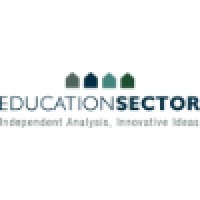Company Details
education-sector
2,513
6,115
921
educationsector.org
0
EDU_2524325
In-progress

Education Sector Company CyberSecurity Posture
educationsector.orgEducation Sector is an independent think tank that challenges conventional thinking in education policy. We are a nonprofit, nonpartisan organization committed to achieving measurable impact in education policy, both by improving existing reform initiatives and by developing new, innovative solutions to our nation’s most pressing education problems. Most of the organizations that come to mind when one says "education policy" either conduct research, represent constituents' interests, or advocate fixed policy agendas. Too often the research is written in language that's hard for policymakers to understand, and thus they don't use a lot of it. And much of the work produced by membership organizations and traditional education advocacy groups is less than objective. This lack of credibility and clarity in research and analysis hurts the cause of education improvement: policymakers make important decisions on the basis of biased information; good ideas don't reach the people with the power to implement them; and it becomes harder to create and sustain an intellectual climate that supports reform. Education Sector was designed to address these problems. Since our founding in 2005, Education Sector has established our expertise in key issue areas—including educational choice, human capital, K–12 accountability, and higher education—and gained credibility as an independent leader in the field. Read more about us here: http://www.educationsector.org/who-we-are.
Company Details
education-sector
2,513
6,115
921
educationsector.org
0
EDU_2524325
In-progress
Between 750 and 799

 Education Sector Global Score (TPRM)
Education Sector Global Score (TPRM)XXXX



No incidents recorded for Education Sector in 2025.
No incidents recorded for Education Sector in 2025.
No incidents recorded for Education Sector in 2025.
Education Sector cyber incidents detection timeline including parent company and subsidiaries

Education Sector is an independent think tank that challenges conventional thinking in education policy. We are a nonprofit, nonpartisan organization committed to achieving measurable impact in education policy, both by improving existing reform initiatives and by developing new, innovative solutions to our nation’s most pressing education problems. Most of the organizations that come to mind when one says "education policy" either conduct research, represent constituents' interests, or advocate fixed policy agendas. Too often the research is written in language that's hard for policymakers to understand, and thus they don't use a lot of it. And much of the work produced by membership organizations and traditional education advocacy groups is less than objective. This lack of credibility and clarity in research and analysis hurts the cause of education improvement: policymakers make important decisions on the basis of biased information; good ideas don't reach the people with the power to implement them; and it becomes harder to create and sustain an intellectual climate that supports reform. Education Sector was designed to address these problems. Since our founding in 2005, Education Sector has established our expertise in key issue areas—including educational choice, human capital, K–12 accountability, and higher education—and gained credibility as an independent leader in the field. Read more about us here: http://www.educationsector.org/who-we-are.


The Civil Service Employees Association (CSEA) is one of the largest and most influential unions in New York and the United States. CSEA has about 300,000 members and represents state, county, municipal, school district, child care, and private sector employees. Formed in 1910, CSEA has improved the
The Today’s Students Coalition is a cross-cutting group of policy, advocacy, and membership organizations who have joined forces to push for urgently needed policy changes that will better serve today’s students. The Coalition is forging new consensus across a diverse group of organizations focused
The Meadows Mental Health Policy Institute is a nonpartisan, nonprofit organization that supports the implementation of policies and programs that help Texans obtain effective, efficient mental health care when and where they need it. The Institute’s vision is for Texas to be the national leader in

De gemeente Montfoort is een meer dan fraaie gemeente in het Groene Hart van ons land. In totaal telt de gemeente zo’n 14.000 inwoners, voornamelijk woonachtig in de stad Montfoort en het dorp Linschoten. De gemeente Montfoort is “gewoon bijzonder en bijzonder gewoon”. We redeneren vanuit dienstver

The Kurdistan Regional Government (KRG) established the Department of Foreign Relations (DFR) in September 2006 to conduct relations with the international community. Today, the DFR is an integral part of the government, with a wide ranging portfolio of responsibilities. The KRG Department of For
The Colorado Children’s Campaign is a nonprofit, nonpartisan advocacy organization committed since 1985 to realizing every chance for every child in Colorado. Using the most accurate, compelling data and research on child well-being and backed by an extensive, statewide network of dedicated child a
.png)
DigiCert partners with Jisc to enhance the UK's education sector security, offering streamlined access to digital trust solutions,...
India's education sector is experiencing an unprecedented digital transformation, driven by the Government of India's revolutionary...
The DIDAC India 2025 & DIDAC Skills, scheduled to be held from 18-20 November 2025 and co-located at Yashobhoomi (India International...
The Ministry of Education has raised concerns over increasing cyber-attack attempts targeting the education sector, with universities...
Infosecurity spoke with a CISO in the education technology sector to explore the cybersecurity lessons from the Kido nursery breach and...
Ransomware recovery is improving, but attackers are getting smarter. An expert explains how constant detection and response can safeguard...
The education sector has seen a swift rise in cybersecurity incidents since 2024, but training, awareness and tools can help ease incidents...
The police are collaborating with the Education Bureau, Hong Kong Education City, and Qianfan Technology to equip schools, teachers,...
As many students across parts of the world return to class, ransomware remains a pressing threat to the education sector.

Explore insights on cybersecurity incidents, risk posture, and Rankiteo's assessments.
The official website of Education Sector is http://www.educationsector.org.
According to Rankiteo, Education Sector’s AI-generated cybersecurity score is 752, reflecting their Fair security posture.
According to Rankiteo, Education Sector currently holds 0 security badges, indicating that no recognized compliance certifications are currently verified for the organization.
According to Rankiteo, Education Sector is not certified under SOC 2 Type 1.
According to Rankiteo, Education Sector does not hold a SOC 2 Type 2 certification.
According to Rankiteo, Education Sector is not listed as GDPR compliant.
According to Rankiteo, Education Sector does not currently maintain PCI DSS compliance.
According to Rankiteo, Education Sector is not compliant with HIPAA regulations.
According to Rankiteo,Education Sector is not certified under ISO 27001, indicating the absence of a formally recognized information security management framework.
Education Sector operates primarily in the Public Policy Offices industry.
Education Sector employs approximately 2,513 people worldwide.
Education Sector presently has no subsidiaries across any sectors.
Education Sector’s official LinkedIn profile has approximately 6,115 followers.
Education Sector is classified under the NAICS code 921, which corresponds to Executive, Legislative, and Other General Government Support.
No, Education Sector does not have a profile on Crunchbase.
Yes, Education Sector maintains an official LinkedIn profile, which is actively utilized for branding and talent engagement, which can be accessed here: https://www.linkedin.com/company/education-sector.
As of November 28, 2025, Rankiteo reports that Education Sector has not experienced any cybersecurity incidents.
Education Sector has an estimated 1,023 peer or competitor companies worldwide.
Total Incidents: According to Rankiteo, Education Sector has faced 0 incidents in the past.
Incident Types: The types of cybersecurity incidents that have occurred include .
.png)
Angular is a development platform for building mobile and desktop web applications using TypeScript/JavaScript and other languages. Prior to versions 19.2.16, 20.3.14, and 21.0.1, there is a XSRF token leakage via protocol-relative URLs in angular HTTP clients. The vulnerability is a Credential Leak by App Logic that leads to the unauthorized disclosure of the Cross-Site Request Forgery (XSRF) token to an attacker-controlled domain. Angular's HttpClient has a built-in XSRF protection mechanism that works by checking if a request URL starts with a protocol (http:// or https://) to determine if it is cross-origin. If the URL starts with protocol-relative URL (//), it is incorrectly treated as a same-origin request, and the XSRF token is automatically added to the X-XSRF-TOKEN header. This issue has been patched in versions 19.2.16, 20.3.14, and 21.0.1. A workaround for this issue involves avoiding using protocol-relative URLs (URLs starting with //) in HttpClient requests. All backend communication URLs should be hardcoded as relative paths (starting with a single /) or fully qualified, trusted absolute URLs.
Forge (also called `node-forge`) is a native implementation of Transport Layer Security in JavaScript. An Uncontrolled Recursion vulnerability in node-forge versions 1.3.1 and below enables remote, unauthenticated attackers to craft deep ASN.1 structures that trigger unbounded recursive parsing. This leads to a Denial-of-Service (DoS) via stack exhaustion when parsing untrusted DER inputs. This issue has been patched in version 1.3.2.
Forge (also called `node-forge`) is a native implementation of Transport Layer Security in JavaScript. An Integer Overflow vulnerability in node-forge versions 1.3.1 and below enables remote, unauthenticated attackers to craft ASN.1 structures containing OIDs with oversized arcs. These arcs may be decoded as smaller, trusted OIDs due to 32-bit bitwise truncation, enabling the bypass of downstream OID-based security decisions. This issue has been patched in version 1.3.2.
Suricata is a network IDS, IPS and NSM engine developed by the OISF (Open Information Security Foundation) and the Suricata community. Prior to versions 7.0.13 and 8.0.2, working with large buffers in Lua scripts can lead to a stack overflow. Users of Lua rules and output scripts may be affected when working with large buffers. This includes a rule passing a large buffer to a Lua script. This issue has been patched in versions 7.0.13 and 8.0.2. A workaround for this issue involves disabling Lua rules and output scripts, or making sure limits, such as stream.depth.reassembly and HTTP response body limits (response-body-limit), are set to less than half the stack size.
Suricata is a network IDS, IPS and NSM engine developed by the OISF (Open Information Security Foundation) and the Suricata community. In versions from 8.0.0 to before 8.0.2, a NULL dereference can occur when the entropy keyword is used in conjunction with base64_data. This issue has been patched in version 8.0.2. A workaround involves disabling rules that use entropy in conjunction with base64_data.

Get company history
















Every week, Rankiteo analyzes billions of signals to give organizations a sharper, faster view of emerging risks. With deeper, more actionable intelligence at their fingertips, security teams can outpace threat actors, respond instantly to Zero-Day attacks, and dramatically shrink their risk exposure window.
Identify exposed access points, detect misconfigured SSL certificates, and uncover vulnerabilities across the network infrastructure.
Gain visibility into the software components used within an organization to detect vulnerabilities, manage risk, and ensure supply chain security.
Monitor and manage all IT assets and their configurations to ensure accurate, real-time visibility across the company's technology environment.
Leverage real-time insights on active threats, malware campaigns, and emerging vulnerabilities to proactively defend against evolving cyberattacks.




